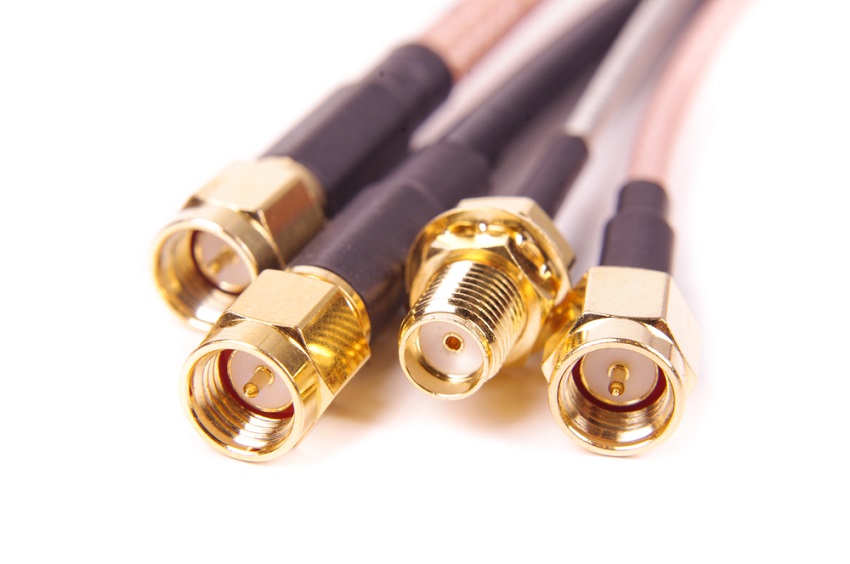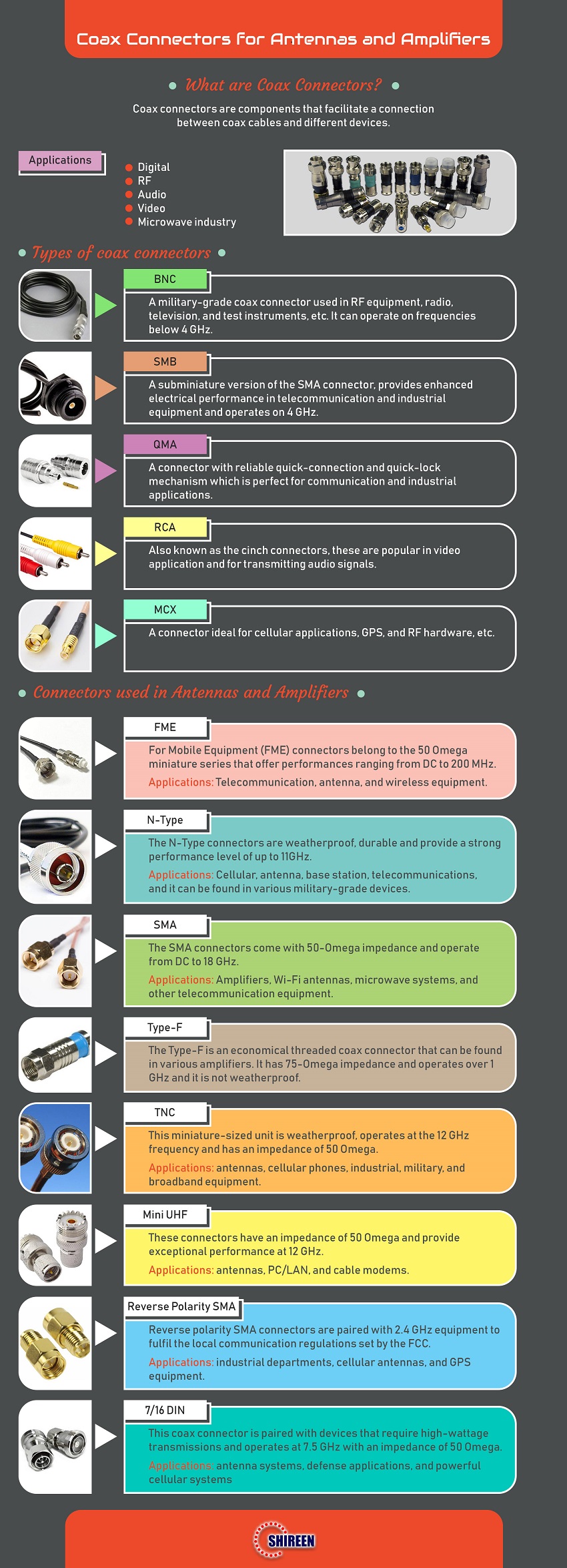Coax connectors play a massive role in cable and wiring needs since they connect cables to devices or form a connection between two cables. With the help of the right connectors, individuals can benefit from long-lasting and reliable connections. However, choosing an incorrect connector with the devices not only affects the connectivity but can also damage the connected cables and devices.
Picking the right coax connector requires more than just a quick trip to the market. There are several other associated factors that you need to know about to make a right choice. Considering this, we will take you through the subjects of genders and reverse polarity before suggesting the best available coax cable connectors for amplifiers and antennas.
What are Coax Connectors?

As you may already know, coax connectors facilitate a connection between coax cables and different devices. Apart from offering a better connection, the right coax connectors can shield the cables from external damage.
It has a variety of applications that range from digital, RF, audio, video, and microwave industries, with each one offering unique benefits to the end-users. There are various types of coax connectors where each one is separated from the other one based on their distinguishing characteristics and intended purposes. The most common types include:
-
BNC
BNC is a military-grade coax connector used in RF equipment, radio, television, and test instruments, etc. It contains two separate bayonet lugs and can operate on frequencies that are below 4 GHz.
-
SMB
A subminiature version of the SMA connector, the SMB provides enhanced electrical performance in telecommunication and industrial equipment. It operates on 4 GHz and comes with a simple snap-on mechanism to ensure a secure connection.
-
QMA
The QMA connectors offer quick and reliable coupling with devices thanks to its quick-connection and quick-lock mechanism. These kinds of connectors are suitable to be used in communication and industrial applications along with cable assembly, wiring, and repair.
-
RCA
Sometimes known as the cinch connectors, the RCA connectors are popular in video application and for transmitting audio signals. The recognizable feature of these connectors is the white, yellow, and red cords that connect with the back of any TV set.
-
MCX
This connector is ideal for applications that have size, weight, or space restrictions. Thanks to its micro size, MCX can be used in cellular applications, GPS, RF hardware, and other wireless applications.
Connector Genders
To make the right decision while choosing coax connectors, you need to be able to identify or differentiate between gendered connectors.
The purpose of connectors is to form a seamless or smooth connection. Trying to plug or ‘mate’ two separate gendered connectors will not fit into each other snugly. Such action could damage the interior of the plug or jack, rendering the device or the cable useless. To avoid committing such a costly mistake, it is better to identify the genders and figure out which part goes where.
As of now, there are only two genders, i.e. male and female. The gender can be easily identified by analyzing the interior of any connector. For instance, if the center contains a protruding pin, it is a male connector and if the connector’s center contains a hole, it is a female connector.
The features that could help identify the genders have stayed the same throughout all the connectors. However, the introduction of Reverse Polarity seems to challenges it all!
Reverse Polarity Connectors
Reverse Polarity connectors are different from ordinary gender ones since their male connectors have the body of a female connector yet have protruding pins. On the other hand, their female connectors have a male body yet have various depressions that accept the pins.
The purpose behind creating Reverse Polarity connectors is to prevent untrained people from connecting wrong gendered connectors with one another. That said, there is no difference in performance between the reserve polarity and standard coax connectors.
Connectors used in Antennas and Amplifiers
There are various coax connectors that are being used in antenna and amplifiers to enhance the performance and boost their capabilities. Below, we have enlisted various coax connectors that facilitate a connection between your antenna or amplifier equipment and your cables.
-
FME
For Mobile Equipment (FME) connectors belong to the 50 Omega miniature series that offer performances ranging from DC to 200 MHz. A low-cost variant, FME has a number of applications in the telecommunication, antenna, and wireless equipment.
The female FME is of a low diameter that allows the attached cables to be inserted into tiny spaces to access the desired location. From there, a male FME adapter is used to connect with the female FME connector. That said, these connectors come in RG-174 and RG-58 to facilitate antenna equipment, splices, extensions, and more.
-
N-Type
The N-Type connectors are weatherproof, durable and provide a strong performance level of up to 11GHz. This connector comes with a variety of applications that include cellular, antenna, base station, telecommunications, and it can be found in various military-grade devices. The N-Type connector also comes in female and male genders and can be found in various amplifiers as well.
-
SMA
The SMA connectors come with 50-Omega impedance and operate from DC to 18 GHz. It comes in various formats such as female, male, right-hand, straight, and bulkhead fitting and offers many uses in amplifiers, Wi-Fi antennas, microwave systems, and other telecommunication equipment. Its sub-miniature size allows it to be used with smaller electronic equipment.
-
Type-F
The Type-F is an economical threaded coax connector that can be found in various amplifiers. It has 75-Omega impedance and operates over 1 GHz. Its female connector comes in fixed 3/8 external threads yet its male version varies from cable to cable. Also, it is not weatherproof.
Due to its size and shape, the Type-F connector is often confused with the SMA kind with many even trying to pair both of these together. Although mating can be achieved between these two, it is not advisable to pair Type-F with SMA connectors due to differences in impedance.
-
TNC
This miniature-sized unit is weatherproof, operates at the 12 GHz frequency and has an impedance of 50 Omega. They come in reversed polarity and a standard version with male and female genders. They are commonly used in antennas, cellular phones, industrial, military, and broadband equipment. Its internal structure allows it to deal with stability and leakage issues.
-
Mini UHF
The miniature UHF connectors are designed for situations or equipment where space, weight, size, and cost are an important issue. These connectors have an impedance of 50 Omega and provide exceptional performance at 12 GHz.
The mini UHF is used in applications that revolve around antennas, PC/LAN, and cable modems. It has crimp type terminations and molded insulators that ensure low installation and maintenance costs.
-
Reverse Polarity SMA
Reverse polarity SMA connectors are paired with 2.4 GHz equipment to fulfil the local communication regulations set by the FCC. It has the same impedance level as that of the standard SMA and comes in female and male genders. That said, it is widely used in industrial departments, cellular antennas, and GPS equipment.
-
7/16 DIN
This coax connector is paired with devices that require high-wattage transmissions such as antenna systems, defense applications, and powerful cellular systems. It operates at 7.5 GHz with an impedance of 50 Omega.
High-Quality Connectors to Enhance Performance
Overlooking the quality of connectors while assembling antennas or any other equipment can lead to disastrous results. Poorly designed coax connectors or inexpensive units can lead to an overall reduced electrical performance. Failing to secure high-quality coax connectors in antennas or amplifiers can lead to a loss of critical video or communication data and can even delay the communication of first responders who rely on powerful wireless communications equipment.
It is also important to choose a coax connector that is compatible with the equipment structure. For instance, coax connectors specifically made for external factors will not fare well when paired with indoor equipment and vice versa. If you pick high-quality coax connectors and pair them with intended devices or equipment, you will not face any performance or degradation issues.
Conclusion
Coax connectors play an important role in facilitating and maintaining a stable connection. However, the available choices and the presence of so many options make it difficult to select the right coax connector. On top of this, the variety of applications, differences in impedance, and performance level of each connector further complicates the selection process. But that is not all since you also need to match the impedance and voltage level of the connectors with that of the joined cables and the intended devices to get the most out of everything.
Making your way through all of this without preparation is nearly impossible. This is why we have created this quick informational guide that will help you navigate this difficult topic. In this guide, we have mentioned the various kinds of coax connectors along with the ones that are extremely popular for its uses in antenna and amplifiers industry. So, go through it as it will help you determine the right weight, size, function, and gender of the coax connectors for your intended device.










Leave A Comment